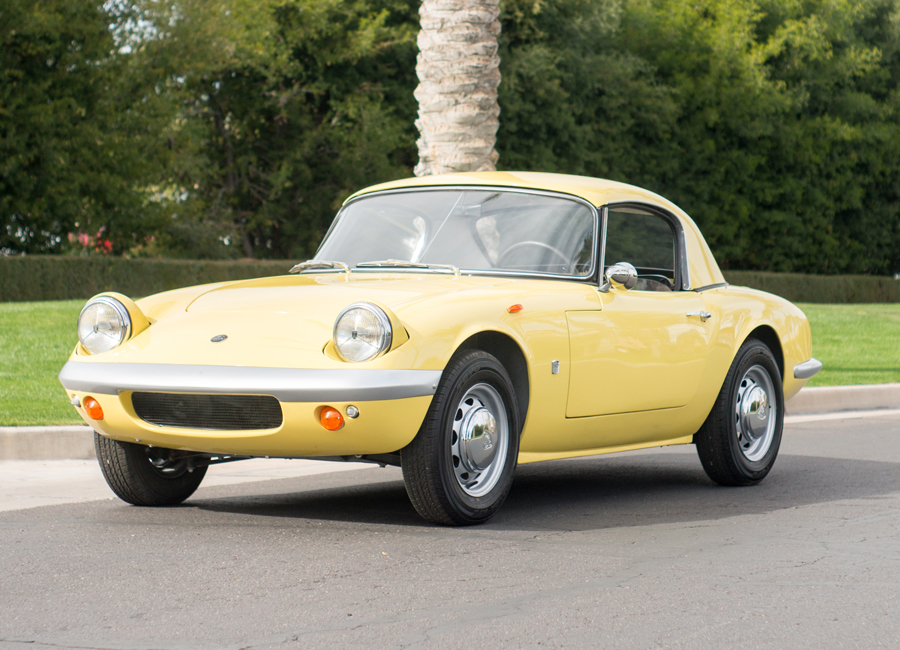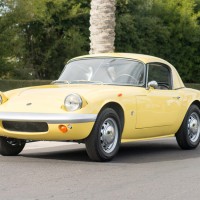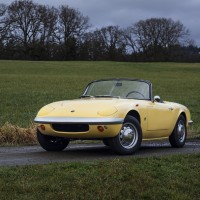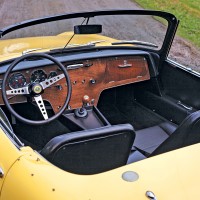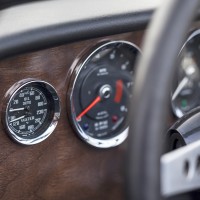SCM Analysis
Detailing
| Vehicle: | 1965 Lotus Elan S2 convertible |
| Years Produced: | 1964–66 |
| Number Produced: | 1,250 |
| Original List Price: | $4,206 |
| SCM Valuation: | Median to date, $34,600; high sale, $60,500 (this car) |
| Tune Up Cost: | $200 |
| Distributor Caps: | $8 |
| Chassis Number Location: | On plate riveted to left-side firewall and on the chassis |
| Engine Number Location: | Stamped on right side of block and on chassis number plate |
| Club Info: | Lotus Ltd. |
| Website: | http://www.lotuscarclub.com |
| Alternatives: | 1959–74 Austin-Healey Sprite, 1962–65 Alfa Romeo Giulia Spider Veloce, 1963–68 MGB |
| Investment Grade: | B |
This car, Lot 168, sold for $60,500, including buyer’s premium, at Bonhams’ Amelia Island, FL, auction on March 10, 2016.
If you’re shopping for a quintessential British sports car of the 1960s, you might choose an E-type Jaguar, a Triumph TR4 or maybe even the last of the MGA line. But if you’re looking for the quickest and most nimble British sports car, it would be hard to do better than a Series 2 Lotus Elan.
The Elan came on the heels of the beautiful Lotus Elite, and it solidified Colin Chapman’s commitment to building cars that could be used on the road and on the race track.
Light, quick and fun
The diminutive Elan weighed just 1,515 pounds, and contemporary American road tests showed actual curb weights as low as 1,485 pounds.
The Series 2 Elan engine was based on the 1,558-cc Ford Kent block, but it has an aluminum twin-cam Lotus head on top. Induction came courtesy of dual Weber 40DCOE side-draft carburetors, and the combination was good for 105 horsepower and 108 pound-feet of torque.
Performance was impressive for the day, with a 0–60 mph time of 7.5 seconds, but where the Lotus really stood out was in its handling. With a lithe suspension at both ends, you just couldn’t beat one of these on an autocross or gymkhana course.
Not cheap fun
The retail price on the North American edition of the 1965 Elan was a steep $4,206. For comparison purposes, a sports car buyer could choose an MG Midget or Austin-Healey Sprite for about $2,000, getting 59 horsepower at a similar size and weight to the Lotus.
Spridget buyers got half the performance of the Elan for half the price. The Lotus Elan was priced competitively with the Corvette roadster, which carried a tag of $4,106, and it was more expensive than the Sunbeam Tiger at $3,499 or the Alfa Romeo Giulia Spider Veloce at $3,514. But each of these competitors hit a different mark on the performance, handling and comfort spectrum.
The Lotus Elan fit into the sports car picture as an expensive and extreme choice — much the same as Lotus cars are viewed today.
The Elan was small, spartan and quick. It renounced all creature comforts in the name of performance. This was a car designed for the club racer and track enthusiast — not for weekend getaways or highway cruising.
That explains why production figures for the Elan range from 9,659 to 12,224 units over the entire production run from 1962 to 1973. The discrepancy in production numbers is a result of the large number of cars sold as kits as a way of skirting British taxes.
The Series 2 is best
Just 1,250 examples of the Series 2 Elan were made between 1964 and 1966, so it’s fair to say that only a few hundred were made in 1965, and most of those would be U.K.-spec cars. As a North American model, the subject Elan was most likely assembled at the Lotus factory in Cheshunt, England.
Among all the Elan variants, the Series 2 Elan is the one to buy because it received several improvements made after the Series 1 cars, including the 1,558-cc engine, revised taillights and a better dashboard, but the car still remains true to the original vision.
Beginning with the Series 3 Elan, the factory made an inexplicable change to fixed side-window frames that destroy the top-down beauty of the car.
Better than factory-new
By all appearances and provenance, this Lotus Elan is about as good as you’re likely to find. Everything was restored properly, and given Lotus’ legendary build-quality issues, this car is certainly in better condition than the day it was put on the boat to America.
The yellow paint is a traditional Lotus color, but it is not original to the car. But honestly, would this car be as impressive in brown? Not a chance.
The factory hard top completes the tableau to make this a head-turning car at any show or racing event. Park it next to the row of E-Type Jags and the gaggle of various Triumph and MG models, and this Lotus will surely stand out.
At a sale price of $60,500, subtracting the auction-house premium yields a final bid price of $55,000. That’s substantially higher than the SCM Pocket Price Guide predicts, but this car is certainly worth top dollar.
The adage about buying the best car you can find applies in this case. The buyer of this Lotus will not be disappointed with the car’s potential for green appreciation — whether in cash or envy — in the years to come. ♦
(Introductory description courtesy of Bonhams.)
